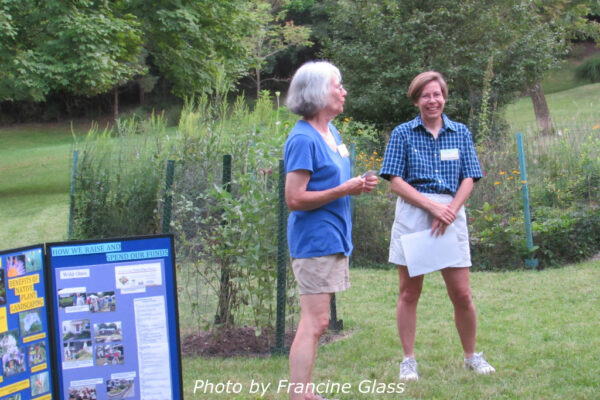September 2 and 5, 2015
Susan Orr hosted two yard tour gatherings this month. A total of 33 members and 6 guests attended.
Susan’s yard is currently Silver Certified by St. Louis Audubon’s Bring Conservation Home program. However, the certification will be upgraded to Gold when she eliminates her property’s small amount of English Ivy. A beautiful boulder water bubbler for birds graces the front yard. Backyard highlights include numerous planting beds, numerous pipevine swallowtail caterpillars, stories of frost flowers and a display board featuring butterflies and their host plants.
In addition to the yard tour, Susan was interviewed by Amy Redfield and Ed Schmidt about her interest in native plant landscaping.
Susan’s inspiration for getting involved in native plant landscaping was her love for birds. She had never gardened before she moved into her house seventeen years ago. She decided to plant native species that would bring birds into her yard. It took three years for her to clear an acre of invasive honeysuckle at the lawn’s edge and in a common area, and once she did, native species began coming up.
One of Susan’s challenges is deer. Despite the fact that deer can easily jump a four-foot-high fence, they won’t jump into an enclosure that is five feet wide or narrower. She has used this information to construct a fencing system to keep the deer out of her numerous garden beds. A recent challenge has been groundhogs. Other wildlife includes 6″ skinks, foxes, a flock of 20 turkeys, box turtles, black snakes, and numerous birds. Butterfly host plants include pipevine for pipevine swallowtails, spicebush for spicebush swallowtails and milkweed for monarchs.
Susan constructed two rain gardens. The larger one is 22 feet long and on a slope. Starting at the lower end, Susan dug the garden six inches deep. She was surprised when she dug to the upper end that it was 1.5 feet deep. She used the excavated soil to create a berm at the lower end. She used no soil amendments, and water empties in a day after a rain.
Susan is trained as a Bring Conservation Home habitat advisor and said she enjoys volunteering. She finds it interesting to talk with homeowners and see their situations, and says all the homeowners are very happy to see the advisors. She has been an advisor for three years and has done 33 consults. One of the things Susan learned in Bring Conservation Home training is that burning bush, mimosa and autumn olive trees are invasive species.
Susan offers the following advice for beginners:
- Do not use fertilizers because they damage the microbes and fungi in soil. Unlike fertilizers, soil microbes and fungi continue to feed plants during drought.
- Use mulch to conserve water and reduce weeds.
- Use pure native species instead of cultivars. Cultivars have been altered, and may not have as many beneficial properties.
ANNOUNCEMENTS
2015 Landscape Challenge Planting – September 12
We co-sponsor a yearly Landscape Challenge with Shaw Nature Reserve and the Missouri Prairie Foundation’s Grow Native! program. This year’s winning yard is in University City. Address is on our website calendar. Volunteers are needed to help plant the yard on Saturday morning, September 12 at 9am. Landscape Designer, Jeanne Cablish, will again design the front yard makeover. See photo gallery.
Native Plant Expo and Sale – September 26
St. Louis Audubon’s Bring Conservation Home program will sponsor a plant swap and sale on September 26, 9:00 am to 2:00pm at Schlafly Bottleworks in Maplewood, MO. Members are encouraged to participate in the plant swap (Missouri native species only). Missouri Wildflowers Nursery and Forrest Keeling Nursery will sell plants at this event. More details.
Celebrating 10 Years of Greener Gardens – October 17
Shaw Nature Reserve’s Native Plant School will celebrate its 10th anniversary on October 17. Our chapter will host an activity table, and this event will take the place of our monthly gathering. Read more about the event.
November annual potluck dinner and seed exchange – November 4, 6:00 PM
This year’s annual potluck dinner and seed exchange will be held at The Heights community center of Richmond Heights. More details on our online calendar.
Wild Ones Annual Conference
Carol and Wes Boshart, who represented our chapter at the 2015 Wild Ones Annual Conference in Wisconsin last month, gave the following short presentation about the weekend.
The WILD (Wild Ones Institute of Learning and Development) Center property is located on a marsh close to Green Bay, Wisconsin. A floating boardwalk has been constructed on the marsh. Carol and Wes found this to be an interesting wetland.
Wild Ones staff and members have developed an expansive native prairie next to the WILD Center, which is a former residence. At the conference, the prairie was named the “Donna VanBuecken Prairie and Native Plant Garden” in honor of the retiring Executive Director. She was Wild Ones’ first Executive Director and has held the position for 17 years.
Several workshops were held during the conference including “Citizen Science Training” with Karen Oberhauser of the University of Minnesota, Monarch Joint Venture and Monarch Larva Monitoring Project. During Karen’s presentation, participants learned to recognize the different stages of the monarch life cycle.
Next Monthly Gathering
October 17
Shaw Nature Reserve’s Native Plant School 10th Anniversary event will take the place of our monthly gathering. Details and directions.
Recorded by: Fran Glass, Secretary


